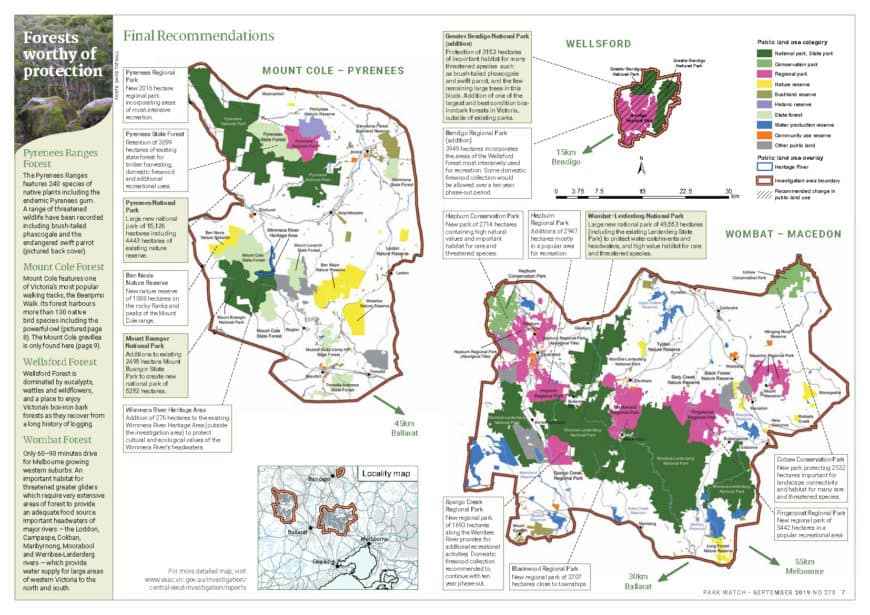PARK WATCH September 2019 |
Right now the Andrews Government has a fantastic opportunity to do our state proud by creating much-needed new national parks for the protection of our forests and the enjoyment of all Victorians.
The state government needs to agree to the final recommendations of the Victorian Environmental Assessment Council (VEAC) to protect almost 60,000 hectares of forest in Victoria’s central west.
These forests worthy of protection include the Wombat Forest (near Daylesford), Wellsford Forest (near Bendigo), Pyrenees Ranges Forest (near Avoca), and Mount Cole Forest (near Beaufort) as well as many smaller forest areas (see maps below).
After decades of community campaigns and a thorough independent investigation, the Andrews Government now needs to move to pass the necessary legislation and associated funding.
A dozen good reasons the Andrews Government should commit to creating these new parks in the central west are:
1. Victoria’s forests of the central west have incredible natural values. Their forests harbour 380 threatened species, such as powerful owl, brush-tailed phascogale (similar to a small quoll), greater gliders and many more.
2. National parks are great for both people and nature. According to the Parks Victoria Annual Report, the Victorian parks estate contributes $2.1 billion annually to the Victorian economy through park tourism, supporting 20,000 jobs.
3. There is growing demand for nature experiences in national parks. In 2017–18, 14 million people took part in at least one nature-based activity, which is up eight per cent year on year. Nature-based visitor numbers have grown by 36 per cent since December 2014.
4. National parks protect natural areas and manage potentially damaging activities while encouraging visitation. Most recreational activities are actively encouraged in national parks including camping, horse riding and mountain biking, and generally the rules regarding activities, such as 4×4 driving, are the same as in state forests. The reserve system has been carefully designed to include almost 20,000 hectares of regional parks close to townships which allow almost all forms of recreation, including dog walking, fossicking and prospecting.
5. New national parks in our state’s central west would be an impressive Andrews Government legacy for future generations of Victorians, and show real leadership on nature conservation.
6. It has been almost a decade since the last major additions to our national parks system in Victoria. The last decade has seen the lowest level of national parks creation in the last 60 years.
7. The Victorian Environmental Assessment Council’s final recommendations were developed through a thorough consultation process over a two-year period. It received 2698 written submissions with a further 450 people attending drop-in sessions and public meetings. These forests had not been formally assessed for over 30 years.
8. Victoria is the most cleared state in Australia and much of our key habitat remains on public land. While public land only covers 40 per cent of the state, it contains 70 per cent of the highest biodiversity values.
9. New parks in the central west will protect some important habitat types currently under-represented in the reserve system, and help deliver key elements of the Victoria’s Biodiversity 2037 strategy. This would once again make Victoria a national leader in nature conservation.
10. New parks will protect significant headwaters of important rivers including the Moorabool, Werribee, Lerderderg, Maribyrnong, and Wimmera rivers.
11. Better protection and management as national park or other conservation reserves will be critical to improve resilience of Victoria’s special places and species in the face of climate change, for example snow gums on Mount Cole.
12. New national parks would be a drawcard for recreation and tourism to the central west of the state. They would be assets to the growing Melbourne population, particularly the western suburbs, giving that community the opportunity to enjoy getting out into nature only a short drive from the city.
Recommendations at a glance
VEAC’S final recommendations propose an increase of almost 60,000 hectares in protected areas in the central west of Victoria (national park, conservation park, nature reserve, bushland reserve or heritage river).
Just over 50,000 hectares of area will be protected under the National Parks Act 1975, which includes new or additions to existing national or state parks, including:
- Wombat–Lerderderg National Park – establishment of a large new national park from existing state park and state forest, capturing a significant amount of the largely-intact landscape and high strategic biodiversity values of the Wombat forest (addition of 29,079 hectares).
- Pyrenees National Park – establishment of a new national park from existing nature reserves and state forest over the southern flanks of the Pyrenees Ranges (addition of 15,126 hectares).
- Mount Buangor National Park – establishment of a new national park from existing state park and some adjoining state forest (addition of 2784 hectares).
- Greater Bendigo National Park – addition of the Wellsford forest to the existing national park (addition of 3152 hectares), and addition to the Bendigo Regional Park (3950 hectares)
- Hepburn (2714 hectares) and Cobaw (2532 hectares) Conservation Parks – establishment of two new conservation parks from state forest north-west of Daylesford and at Cobaw.
- Thirty new smaller conservation reserves (5246 hectares), nature reserves (1348 hectares) bushland reserves (1761 hectares).
- New heritage river designation upper reaches of the Wimmera River in Mount Cole.
An additional 19,728 hectares of regional parks managed primarily for recreation, in areas of highest recreational activity near towns, is also proposed.
Next steps
VEAC’s Central West Investigation final recommendations were released in June 2019, and have been tabled in the Victorian Parliament.
The Andrews Government has roughly six months to provide a response in parliament (likely in February 2020), though it can make a decision earlier.
Once the government agrees to commit to creating the new national parks, legislation needs to be drafted and passed by both houses of parliament. This is usually associated with an implementation-funding package to build appropriate infrastructure (such as signage, campground and picnic areas), conduct urgent feral animal or pest control, employ rangers and develop a park management plan. This can take some years to complete, and the sooner the resources are available, the better.
Now is the time for action
We are calling on the Andrews Government to:
- Publicly support all of the final VEAC recommendations
- Decide earlier rather than later, to allow for legislation and park implementation to be undertaken well within this term of government
- Provide appropriate resources for park establishment and management
More
You can stay up to date on developments and support our campaign to protect the central west forests here.
Did you like reading this article? Want to be kept up to date about this and other nature issues in Victoria? Subscribe to our email updates.
You can also receive our print magazine Park Watch four times a year by becoming a member. Find out more here.

